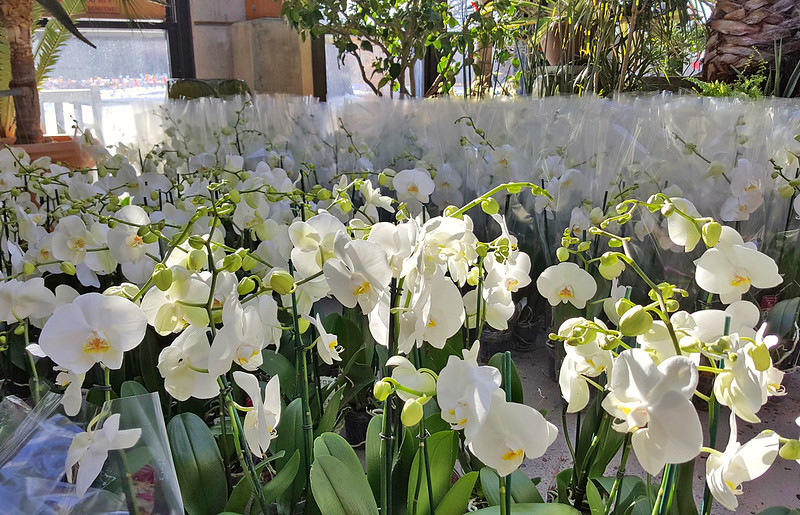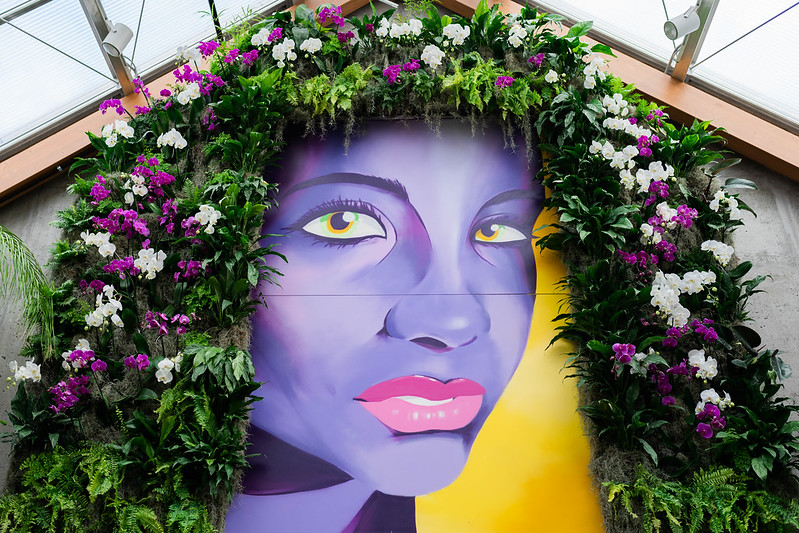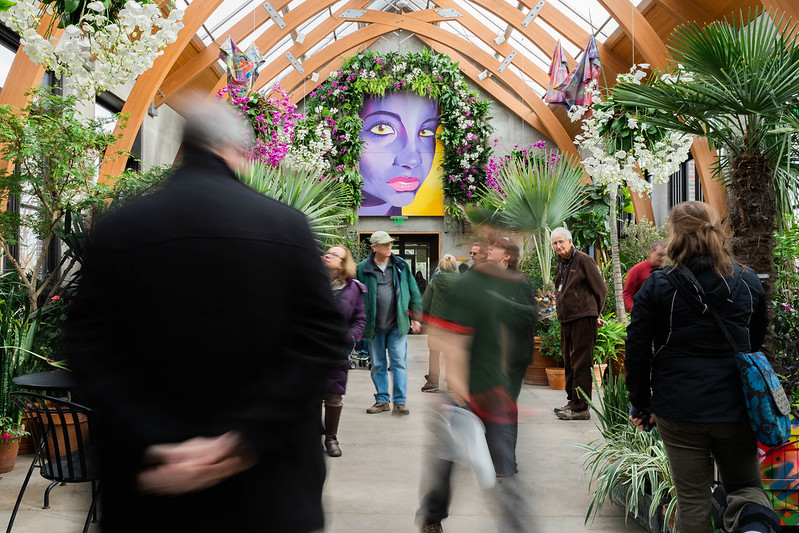By Kyle Jacoby
Manager of Exhibitions
As you entered the Limonaia during the 2020 Orchid Show you were greeted by a stunning display of art and horticulture. There was no better representation of these two things working together than Eden. Sitting high up on the eastern wall of the conservatory was the face of Eden, beautifully crafted by Artist Croc, surrounded by floral hair designed by our Horticulture Team. Eden captured the imagination and wonder of visitors throughout the Orchid Show. Each day chatter filled the Limonaia. How did it come together? Where did the idea come from? How are the plants hanging up there? These are just a few of the many questions that puzzled visitors. I’m here to give you a glimpse into the process of how Eden came to be.
The Idea
 Exhibitions are typically guided by a theme. This theme acts as a big idea we want everything to connect back to. Themes guide us in our decision making and help create an impactful, meaningful and holistic experience for our visitors. For the Orchid Show our theme was all about how nature and humans are connected. Once we have this theme, we can begin to brainstorm how to bring it into reality. In a series of meetings between our Education Team, Horticulture Team, Facilities Team and the Artist we began to piece a plan together for how the Orchid Show would look based on our theme. It was during those meetings that the idea for a street art designed face surrounded by floral hair emerged. This would be a perfect blend of human and nature in one display. When ideas surface, we get an initial agreement that we all feel it can be done. However, the finer details tend to emerge later. One thing was certain though. We wanted this face to be big and to hang it on the wall of the Limonaia.
Exhibitions are typically guided by a theme. This theme acts as a big idea we want everything to connect back to. Themes guide us in our decision making and help create an impactful, meaningful and holistic experience for our visitors. For the Orchid Show our theme was all about how nature and humans are connected. Once we have this theme, we can begin to brainstorm how to bring it into reality. In a series of meetings between our Education Team, Horticulture Team, Facilities Team and the Artist we began to piece a plan together for how the Orchid Show would look based on our theme. It was during those meetings that the idea for a street art designed face surrounded by floral hair emerged. This would be a perfect blend of human and nature in one display. When ideas surface, we get an initial agreement that we all feel it can be done. However, the finer details tend to emerge later. One thing was certain though. We wanted this face to be big and to hang it on the wall of the Limonaia.
How would we do it?
Not long after we solidified the displays for the Orchid Show we needed to finalize the size of Eden. This would be critical because our Horticulture Team would need it to plan for the floral hairpiece. Math was very important in this initial planning. Without accurate math everything would be thrown off. So the Limonaia wall was measured to understand the space we had to work with. A scale of the eastern wall of the Limonaia was then sent to Croc. Based on those measurements he suggested a 10×7 face which would leave plenty of space for the surrounding floral hair while also providing the size we were looking for. We all agreed, and Croc had what he needed to begin painting.
The next step was to figure out how the floral hair would be designed and arranged. This challenge presented a lot of questions. What material could be used that would easily secure to the wall? How would we water the plants without needing a lift? How would this fit around the face without harming the artwork? How can we complete it without any of the hair structure showing? It was these and other questions that helped guide us towards finding solutions. That solution came in the form of plywood and lots of nails.
The plan was to use ¾” marine grade plywood cut out in the desired shape of hair piece. Plywood would allow us to secure it safely to the wall with a series of bolts and cables. Hundreds of 4” stainless steel nails would then be hammered through the back of the plywood. These nails would be used to support the arrangement of pots the flowers would be in. Two nails per pot would be angled upwards at 45 degrees. The pot would then slide onto the nail. This would allow for simple and quick plant installation which was important because the plants could not be added until the week before the show. Once the structure (without pots) was hung on the wall a drip system would be attached to the plywood. This system would run down the wall and could be turned on when watering needed to be done. Having a drip watering system would allow for plant management to be done without a lift which was important for creating a positive visitor experience. We had the plan now it was time to get to work.
Hair Plant Species
1) Nephrolepis exaltata ‘Tiger’
2) Philodendron ‘Rojo Congo’
3) Blechnum
4) Davallia
5) Spathiphyllum ‘Domino’
6) Tillandsia usneoides
7) Phalaenopsis
8) Pteris cretica
Preparing the Hair
It was very important that the plywood structure had perfect measurements. This is because the structure would go up first and hang on the wall. Once it was hung, the canvases would slide into the structure. If it was to small the canvas wouldn’t fit. If it was too big the floral hair would not look like it was a part of the face. Both mistakes would mean redoing the plywood structure which would not be a simple or quick fix. If that happened our timeline would be impacted and greatly threaten our ability to open the show on time.
To ensure our structure was the right size the Horticulture team used the measurements from the wall of the Limonaia plus the measurements of the canvases to do some well thought out math. The entire structure would consist of five pieces of plywood attached to one another. One side would be made slightly larger to match the slight turn in the face that was being painted. Once this structure was put together the nails would then need to go in. This would also take some well thought out math because the plants would not be hung on the structure until it was put on the wall. Any nails that were out of place could create a gap in the hair which would be hard to fix with it on the wall.
Based on the 6” pot size it was determined that the plants would be spaced 12” apart. The nails would then be bent at about a 45-degree angle, and each plant would be attached to two nails for stability. The plants would be “hung” on the nails by driving the nails through the sides of the plastic pots. So one by one the nails were hammered through the back of the plywood and bent upwards. All the nails would need to put into place prior to raising so that when the structure was hung on the wall it would be ready for plants to be added. The finishing touches were to paint the plywood black to help hide it from view.
Installation
We had our hair structure complete and ready to install. Many installations only span a couple of days, so every detail needed to be well organized. Through our planning meetings, we knew the plywood structure would need to go up first and be secured to the wall. Once it was secured the canvas would slide into place. After everything was hung the Horticulture Team would then be able to go back and attach the irrigation system and plants the following week. This effort would take all teams working together to make it happen.
The first task to complete was getting the plywood structure hung and attached securely. To do this bolts were attached to the structure and to one of the trusses of the Limonaia. Aircraft cable would then be connected to each set of bolts. Multiple connection points were made in order to create a more secure structure that could manage the weight of the plywood and plants. In order to keep us on time hanging the plywood was conducted the day before the Artist arrived with Eden so we could get straight into hanging the artwork when Croc was onsite.
Once Croc arrived with the painting it was time to see if all our math paid off. First, we had to decide how to raise the artwork slowly into place and secure it. This would be important because the gap between the plywood and canvas would hopefully be small. It was determined that with a pulley system we could raise up the artwork slowly and then secure both sets of aircraft cable simply.
Cables were attached to anchors on the artwork first and then up through bolts on the truss and then down to the ground. Each cable had a team that would slowly lift the artwork as it was guided by the lift. Inch by each it was raised until the moment of truth, would it fit into the structure? Too big or too small would mean redoing the whole thing and putting our timeline at risk. As we approached the plywood the canvas just barely slid into place. The math was perfect! We carefully raised the artwork all the way to the top and secured Eden into her new home. We now had the base set and could move on to the next challenge of adding irrigation and then the plants to complete the floral arrangement.

Finished
As the Friday before opening day came to a close Eden was complete. The hard work of so many people had finally come to life. The brainstorms, ideas, and hopes that were so abstract were now something tangible. It can be a little scary before that moment. Visitors would all be coming the next day and before that moment we had not seen the finished product. However, this was one of those moments where the vision came out better than expected. The Artist Croc created a captivating art piece. The Horticulture Team designed a floral arrangement that showcased the beauty of plants. The Facilities Team secured it all into place to create a positive visitor experience. We couldn’t wait to show everyone. The following day the gardens filled with people all coming to see the show. As they entered the Limonaia Eden was there to greet them. Each visitor captivated by the welcome. And the rest was history!

